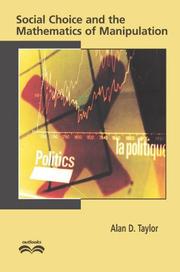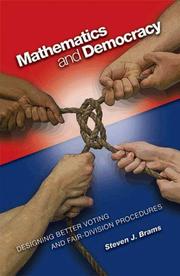| Listing 1 - 3 of 3 |
Sort by
|

ISBN: 0521008832 0521810523 9780521008839 9780521810524 9780511614316 0511115385 9780511115387 9780511114830 0511114834 0511614314 1280449470 9781280449475 1107132363 9781107132368 0511197217 9780511197215 0511298587 9780511298585 051117148X Year: 2005 Publisher: Cambridge Cambridge University Press
Abstract | Keywords | Export | Availability | Bookmark
 Loading...
Loading...Choose an application
- Reference Manager
- EndNote
- RefWorks (Direct export to RefWorks)
Honesty in voting, it turns out, is not always the best policy. Indeed, in the early 1970s, Allan Gibbard and Mark Satterthwaite, building on the seminal work of Nobel laureate Kenneth Arrow, proved that with three or more alternatives there is no reasonable voting system that is non-manipulable; voters will always have an opportunity to benefit by submitting a disingenuous ballot. The ensuing decades produced a number of theorems of striking mathematical naturality that dealt with the manipulability of voting systems. This 2005 book presents many of these results from the last quarter of the twentieth century, especially the contributions of economists and philosophers, from a mathematical point of view, with many new proofs. The presentation is almost completely self-contained, and requires no prerequisites except a willingness to follow rigorous mathematical arguments. Mathematics students, as well as mathematicians, political scientists, economists and philosophers will learn why it is impossible to devise a completely unmanipulable voting system.
Microeconomics --- Voting --- Social choice --- Political science --- Game theory. --- Mathematical models. --- Games, Theory of --- Theory of games --- Mathematical models --- Mathematics --- Polls --- Elections --- Politics, Practical --- Suffrage --- Balloting --- Voting - Mathematical models. --- Social choice - Mathematical models. --- Political science - Mathematical models.

ISBN: 1282531603 9786612531606 1400835593 0691133212 9781400835591 0691133204 9780691133201 9780691133218 9781282531604 6612531606 Year: 2009 Publisher: Princeton, NJ
Abstract | Keywords | Export | Availability | Bookmark
 Loading...
Loading...Choose an application
- Reference Manager
- EndNote
- RefWorks (Direct export to RefWorks)
Voters today often desert a preferred candidate for a more viable second choice to avoid wasting their vote. Likewise, parties to a dispute often find themselves unable to agree on a fair division of contested goods. In Mathematics and Democracy, Steven Brams, a leading authority in the use of mathematics to design decision-making processes, shows how social-choice and game theory could make political and social institutions more democratic. Using mathematical analysis, he develops rigorous new procedures that enable voters to better express themselves and that allow disputants to divide goods more fairly. One of the procedures that Brams proposes is "approval voting," which allows voters to vote for as many candidates as they like or consider acceptable. There is no ranking, and the candidate with the most votes wins. The voter no longer has to consider whether a vote for a preferred but less popular candidate might be wasted. In the same vein, Brams puts forward new, more equitable procedures for resolving disputes over divisible and indivisible goods.
Elections - Mathematical models. --- Elections -- Mathematical models. --- Finance, Public - Mathematical models. --- Finance, Public -- Mathematical models. --- Voting - Mathematical models. --- Voting -- Mathematical models. --- Voting --- Elections --- Finance, Public --- Government - General --- Political Institutions & Public Administration - General --- Law, Politics & Government --- Mathematical models --- Electoral politics --- Franchise --- Polls --- Mathematical models. --- Politics, Practical --- Social choice --- Suffrage --- Political science --- Plebiscite --- Political campaigns --- Representative government and representation --- JSTOR-DDA --- Public finance --- Multi-User. --- E-books --- Balloting
Book
ISBN: 3642031064 9786612971655 3642031072 1282971654 9783642031069 Year: 2010 Publisher: Berlin : Springer,
Abstract | Keywords | Export | Availability | Bookmark
 Loading...
Loading...Choose an application
- Reference Manager
- EndNote
- RefWorks (Direct export to RefWorks)
The likelihood of observing Condorcet's Paradox is known to be very low for elections with a small number of candidates if voters’ preferences on candidates reflect any significant degree of a number of different measures of mutual coherence. This reinforces the intuitive notion that strange election outcomes should become less likely as voters’ preferences become more mutually coherent. Similar analysis is used here to indicate that this notion is valid for most, but not all, other voting paradoxes. This study also focuses on the Condorcet Criterion, which states that the pairwise majority rule winner should be chosen as the election winner, if one exists. Representations for the Condorcet Efficiency of the most common voting rules are obtained here as a function of various measures of the degree of mutual coherence of voters’ preferences. An analysis of the Condorcet Efficiency representations that are obtained yields strong support for using Borda Rule.
Voting --- Mathematical models. --- Condorcet, Jean-Antoine-Nicolas de Caritat, --- Political science. --- Political economy. --- Game theory. --- Economic theory. --- Public finance. --- Economics. --- Economic Theory/Quantitative Economics/Mathematical Methods. --- Political Economy. --- Public Economics. --- Political Science. --- Game Theory, Economics, Social and Behav. Sciences. --- Polls --- Elections --- Politics, Practical --- Social choice --- Suffrage --- Caritat, Jean-Antoine-Nicolas de, --- Condorcet, Antoine-Nicolas Caritat de, --- Condorcet, C.-F., --- Condorcet, Marie Jean Antoine Nicolas, --- Condorcet, --- De Caritat, Jean-Antoine-Nicolas, --- Kondorsė, Zhan Antuan, --- Mathematics. --- International Political Economy. --- Math --- Science --- Administration --- Civil government --- Commonwealth, The --- Government --- Political theory --- Political thought --- Politics --- Science, Political --- Social sciences --- State, The --- Cameralistics --- Public finance --- Currency question --- Economic theory --- Political economy --- Economic man --- Public finances --- Games, Theory of --- Theory of games --- Mathematical models --- Mathematics --- de Caritat, Jean-Antoine-Nicolas, --- Condorcet --- Condorcet, Jean-Antoine-Nicolas de Caritat --- de Condorcet, Marie Jean Antoine Nicolas de Caritat --- de Condorcet, Nicolas --- Schwartz, Joachim, --- Game theory --- Voting - Mathematical models --- Paradoxes --- Condorcet, Jean-Antoine-Nicolas de Caritat, - marquis de, - 1743-1794
| Listing 1 - 3 of 3 |
Sort by
|

 Search
Search Feedback
Feedback About UniCat
About UniCat  Help
Help News
News